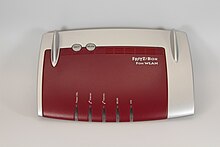
Integrated Services Digital Network (ISDN) is a set of communication standards for simultaneous digital transmission of voice, video, data, and other network services over the digitalised circuits of the public switched telephone network. Work on the standard began in 1980 at Bell Labs and was formally standardized in 1988 in the CCITT "Red Book". By the time the standard was released, newer networking systems with much greater speeds were available, and ISDN saw relatively little uptake in the wider market. One estimate suggests ISDN use peaked at a worldwide total of 25 million subscribers at a time when 1.3 billion analog lines were in use. ISDN has largely been replaced with digital subscriber line (DSL) systems of much higher performance.
Digital subscriber line is a family of technologies that are used to transmit digital data over telephone lines. In telecommunications marketing, the term DSL is widely understood to mean asymmetric digital subscriber line (ADSL), the most commonly installed DSL technology, for Internet access.
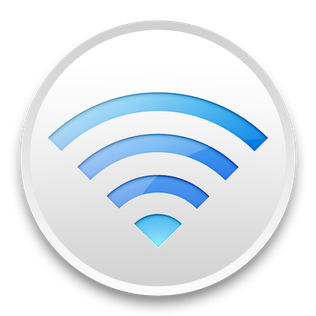
AirPort is a discontinued line of wireless routers and network cards developed by Apple Inc. using Wi-Fi protocols. In Japan, the line of products was marketed under the brand AirMac due to previous registration by I-O Data.

A digital subscriber line access multiplexer is a network device, often located in telephone exchanges, that connects multiple customer digital subscriber line (DSL) interfaces to a high-speed digital communications channel using multiplexing techniques. Its cable internet (DOCSIS) counterpart is the cable modem termination system.

Bell Internet, originally and frequently still called Sympatico, is the residential Internet service provider (ISP) division of BCE Inc. As of May 3, 2012, Bell Internet had over 3 million subscribers in Ontario and Quebec, making it the largest ISP in Canada.
A wireless gateway routes packets from a wireless LAN to another network, wired or wireless WAN. It may be implemented as software or hardware or a combination of both. Wireless gateways combine the functions of a wireless access point, a router, and often provide firewall functions as well. They provide network address translation (NAT) functionality, so multiple users can use the internet with a single public IP. It also acts like a dynamic host configuration protocol (DHCP) to assign IPs automatically to devices connected to the network.
The Freebox is an ADSL-VDSL-FTTH modem and a set-top box that the French Internet service provider named Free provides to its DSL-FTTH subscribers.
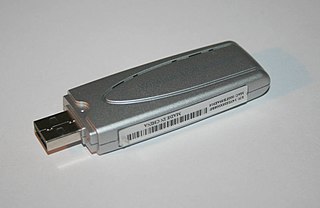
A wireless network interface controller (WNIC) is a network interface controller which connects to a wireless network, such as Wi-Fi, Bluetooth, or LTE (4G) or 5G rather than a wired network, such as an Ethernet network. A WNIC, just like other NICs, works on the layers 1 and 2 of the OSI model and uses an antenna to communicate via radio waves.
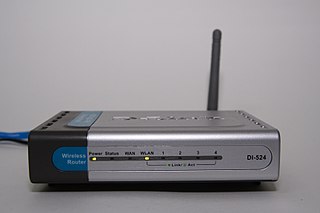
A wireless router or Wi-Fi router is a device that performs the functions of a router and also includes the functions of a wireless access point. It is used to provide access to the Internet or a private computer network. Depending on the manufacturer and model, it can function in a wired local area network, in a wireless-only LAN, or in a mixed wired and wireless network.
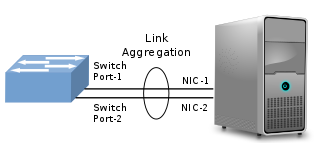
In computer networking, link aggregation is the combining of multiple network connections in parallel by any of several methods. Link aggregation increases total throughput beyond what a single connection could sustain, and provides redundancy where all but one of the physical links may fail without losing connectivity. A link aggregation group (LAG) is the combined collection of physical ports.

A digital subscriber line (DSL) modem is a device used to connect a computer or router to a telephone line which provides the digital subscriber line (DSL) service for connection to the Internet, which is often called DSL broadband. The modem connects to a single computer or router, through an Ethernet port, USB port, or is installed in a computer PCI slot.
Qualcomm Atheros is a developer of semiconductor chips for network communications, particularly wireless chipsets. The company was founded under the name T-Span Systems in 1998 by experts in signal processing and VLSI design from Stanford University, the University of California, Berkeley, and private industry. The company was renamed Atheros Communications in 2000 and it completed an initial public offering in February 2004, trading on the NASDAQ under the symbol ATHR.
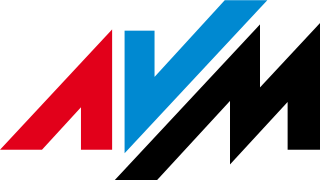
AVM is a consumer electronics company founded in 1986 in Berlin, Germany. The company produces communications, networking devices such as DSL, ISDN, Wireless and VoIP products. It had sales of €620 million in 2022 with 880 employees achieving an estimated profit between €80 and €90 million. It is well known for its popular FRITZ!Box series.

SpeedTouch is the brand name of a line of networking equipment produced by Alcatel and Technicolor SA. Before 27 January 2010 Technicolor was known as Thomson SA.
The DSL-G604T is a first D-Link Wireless/ADSL router which firmware is based on open source the MontaVista Linux. The DSL-G604T was introduced in November 2004. This model has been discontinued.
The DG834 series are popular ADSL modem router products from Netgear. The devices can be directly connected to the phone line and establish an ADSL broadband Internet connection to the ISP and share it among several computers via 802.3 Ethernet and 802.11b/g wireless data links.
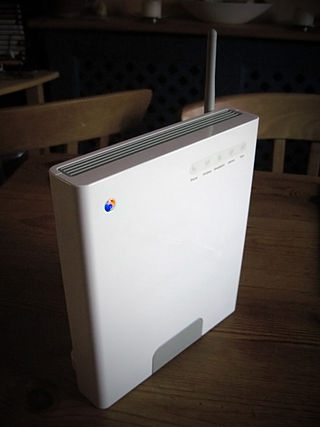
The BT Smart Hub is a family of wireless residential gateway router modems distributed by BT for use with their own products and services and those of wholesale resellers but not with other Internet services. Since v 5 Home/Smart Hubs support the faster Wi-Fi 802.11ac standard, in addition to the 802.11b/g/n standards. All models of the Home Hub prior to Home Hub 3 support VoIP Internet telephony via BT's Broadband Talk service, and are compatible with DECT telephone handsets. Since the Home Hub 4, all models have been dual band.

The Texas Instruments AR7 or TI-AR7 is a fully integrated single-chip ADSL CPE access router solution. The AR7 combines a MIPS32 processor, a DSP-based digital transceiver, and an ADSL analog front end.
Linksys manufactures a series of network routers. Many models are shipped with Linux-based firmware and can run third-party firmware. The first model to support third-party firmware was the very popular Linksys WRT54G series.

The O2 Wireless Box is a wireless residential gateway router distributed by O2. The latest version is based on the 802.11n standard and also supports 802.11g and 802.11b devices. The device connects to the Internet using either an ADSL2+ or ADSL connection.


